| Name |
Image |
Current location |
Discovered |
Date |
Writing |
Significance |
| Autobiography of Weni |
 |
Cairo Museum |
1880, Abydos |
c.2280 BCE |
Egyptian hieroglyphs |
Records the earliest known Egyptian military campaigns in Sinai and the Levant. |
| Sebek-khu Stele |
 |
Manchester Museum |
1901, Abydos |
c.1860 BCE |
Egyptian hieroglyphs |
Records the earliest known Egyptian military campaign in Retjenu, including Sekmem (s-k-m-m, thought to be Shechem). |
| Statue of Idrimi |
 |
British Museum |
1939, Alalakh |
c.1500 BCE |
Akkadian cuneiform |
Records the earliest certain cunei form reference to Canaan |
| Merneptah Stele |
 |
Cairo Museum |
1896, Thebes |
c. 1209 BCE |
Egyptian hieroglyphs |
While alternative translations have been put forward, the majority of biblical archeologists translate a set of hieroglyphs on Line 27 as "Israel", such that it represents the first documented instance of the name Israel in the historical record, and the only record in Ancient Egypt. |
| Bubastite Portal |
 |
Original location |
1828, Karnak |
c. 925 BCE |
gyptian hieroglyphs |
Records the conquests and military campaigns in c.925 BCE of Shoshenq I, of the Twenty-second Dynasty, identified with the biblical Shishaq. Towns identified include Rafah (rph), Megiddo (mkdi) and Ajalon (iywrn) |
| Mesha Stele |
 |
Louvre |
1868, Dhiban, Jordan |
c.850 BCE |
Moabite language |
Describes the victories of Moabite king Mesha over the House of Omri (kingdom of Israel), it bears the earliest certain extra-biblical reference to the Israelite god Yahweh, and—if French scholar André Lemaire's reconstruction of a portion of line 31 is correct—the earliest mention of the "House of David" (i.e., the kingdom of Judah). One of the only two known artifacts containing the "Moabite" dialect of Canaanite languages (the second is the El-Kerak Inscription) |
| Kurkh Monoliths |
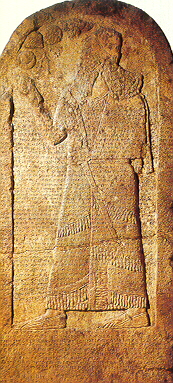 |
British Museum |
1861, Üçtepe, Bismil |
c.850 BCE |
Assyrian cuneiform |
The Shalmaneser III monolith contains a description of the Battle of Qarqar at the end. This description contains the name "A-ha-ab-bu Sir-ila-a-a" which is generally accepted to be a reference to Ahab king of Israel,[4][5] although it is the only known reference to the term "Israel" in Assyrian and Babylonian records, a fact brought up by some scholars who dispute the proposed translation. |
| Black Obelisk of Shalmaneser III |
 |
British Museum |
1846, Nimrud |
c.825 BCE |
Assyrian cuneiform |
Contains what is thought to be the earliest known picture of a biblical figure: possibly Jehu son Omri (mIa-ú-a mar mHu-um-ri-i), or Jehu's ambassador, kneeling at the feet of Shalmaneser III. |
| Saba'a Stele |
 |
Istanbul Archaeology Museums |
1905, Saba'a |
c.800 BCE |
Assyrian cuneiform |
Records Adad-Nirari III's Assyrian campaign to Pa-la-áš-tu (Philistia) |
| Tel Dan Stele |
 |
Israel Museum |
1993, Tel Dan |
c.800 BCE |
Old Aramaic |
Its significance for the biblical version of Israel's past, particularly in lines 8 and 9, which mention a "king of Israel" and a "house of David". The latter is generally understood by scholars to refer to the ruling dynasty of Judah. Although the meaning of this phrase has been disputed by the minority of scholars, today it is generally accepted as a reference to Davidic dynasty.[8][9][10][11] |
| Nimrud Slab |
 |
Unknown |
1854, Nimrud |
c.800 BCE |
Akkadian cuneiform |
Describes Adad-nirari III's early Assyrian conquests in Palastu (Phillistia), Tyre, Sidon, Edom and Humri (the latter understood as the Kingdom of Israel (Samaria)). |
| Nimrud Tablet K.3751 |
 |
British Museum |
c.1850, Nimrud |
c.733 BCE |
Akkadian cuneiform |
Describes Tiglath-Pileser III's (745 to 727 BCE) campaigns to the region, including the first known archeological reference to Judah (Yaudaya or KUR.ia-ú-da-a-a). |
| Sargon II's Prism A |
N.A. |
British Museum |
c.1850, Library of Ashurbanipal |
c.710 BCE |
Akkadian cuneiform |
Describes Sargon II's (722 to 705 BCE) campaigns to Palastu, Judah, Edom and Moab. |
| Siloam inscription |
 |
Istanbul Archaeology Museums |
1880, Siloam tunnel |
c.701 BCE |
Paleo-Hebrew) |
Records the construction of Siloam tunnel |
| Lachish relief |
 |
British Museum |
1845, Nineveh |
c.700 BCE |
Assyrian cuneiform |
Portion of the Sennacherib relief, which depicts captives from Judah being led into captivity after the Siege of Lachish in 701 BC |
| LMLK seals |
 |
Various |
1870 onwards |
c.700 BCE |
Phoenician alphabet (also known as Paleo-Hebrew) |
c.2,000 stamp impressions, translated as "belonging to the King" |
| Azekah Inscription |
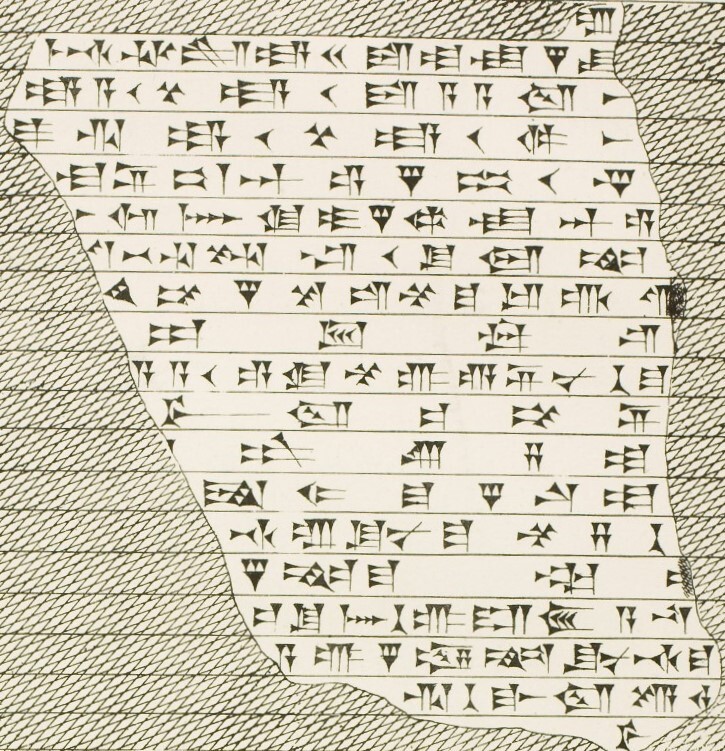 |
British Museum |
c.1850, Library of Ashurbanipal |
c.700 BCE |
Akkadian cuneiform |
Describes an Assyrian campaign by Sennacherib against Hezekiah, King of Judah, including the conquest of Azekah. |
| Sennacherib's Annals |
 |
British Museum, Oriental Institute of Chicago, and the Israel Museum |
1830, likely Nineveh, unprovenanced |
c.690 BCE |
Assyrian cuneiform |
Describes the Assyrian king Sennacherib's siege of Jerusalem in 701 BCE during the reign of king Hezekiah. |
| Esarhaddon's Treaty with Ba'al of Tyre |
 |
British Museum |
c.1850, Library of Ashurbanipal |
c.675 BCE |
Akkadian cuneiform |
Describes a treaty between Esarhaddon (reigned 681 to 669 BCE) and Ba'al of Tyre with respect to pi-lis-te |
| Ekron inscription |
 |
Israel Museum |
1996, Ekron |
c.650 BCE |
Phoenician alphabet |
The first known inscription from the area ascribed to Philistines |
| Cylinders of Nabonidus |
 |
British Museum and Pergamon Museum |
1854, Ur |
c.550 BCE |
Akkadian cuneiform |
Describes Belshazzar (Balthazar) as Nabonidus' eldest son |
| Nebuchadnezzar Chronicle |
(Photo Gallery)[15] |
British Museum |
1896 (acquired), unprovenanced |
c.550 – 400 BCE [16] |
Akkadian cuneiform |
Describes Nebuchadnezzar's first siege of Jerusalem in 597 BCE, the Siege of Jerusalem (597 BCE) |
| Cylinder of Cyrus |
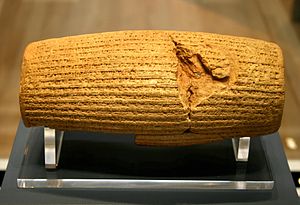 |
British Museum |
1879, Babylon |
c.530 BCE |
Akkadian cuneiform |
King >Cyrus's treatment of religion, which is significant to the books of Chronicles, Ezra and Nehemiah. |
| Nabonidus Chronicle |
 |
British Museum |
1879 (acquired), Sippar, unprovenanced |
4th –1st century BCE[17] |
Akkadian cuneiform |
Describes the conquest of Babylon by the Persian king Cyrus the Great |
| Temple Warning inscription |
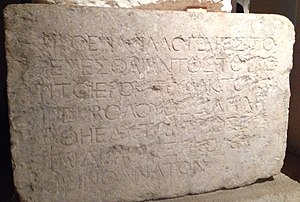 |
Istanbul Archaeology Museums |
1871, Jerusalem |
c.23 BCE – 70 CE |
Greek |
Believed to be an inscription from >Herod's Temple, warning foreigners ("allogenē") to refrain from entering the Temple enclosure |
| Trumpeting Place inscription |
 |
Israel Museum |
1968, Jerusalem |
c.1st century CE |
Hebrew[19] |
Believed to be a directional sign for the priests who blew a trumpet, consistent with an account in Josephus |
| Arch of Titus |
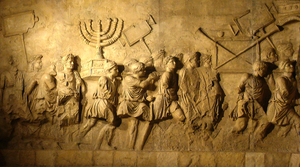 |
Original location |
n.a., Roma |
c.82 CE |
Latin |
Relief showing spoils from the Sack of Jerusalem by Titus in 70 CE. Depicted are the menorah and trumpets, as well as what might be the Table of Showbread. |
























